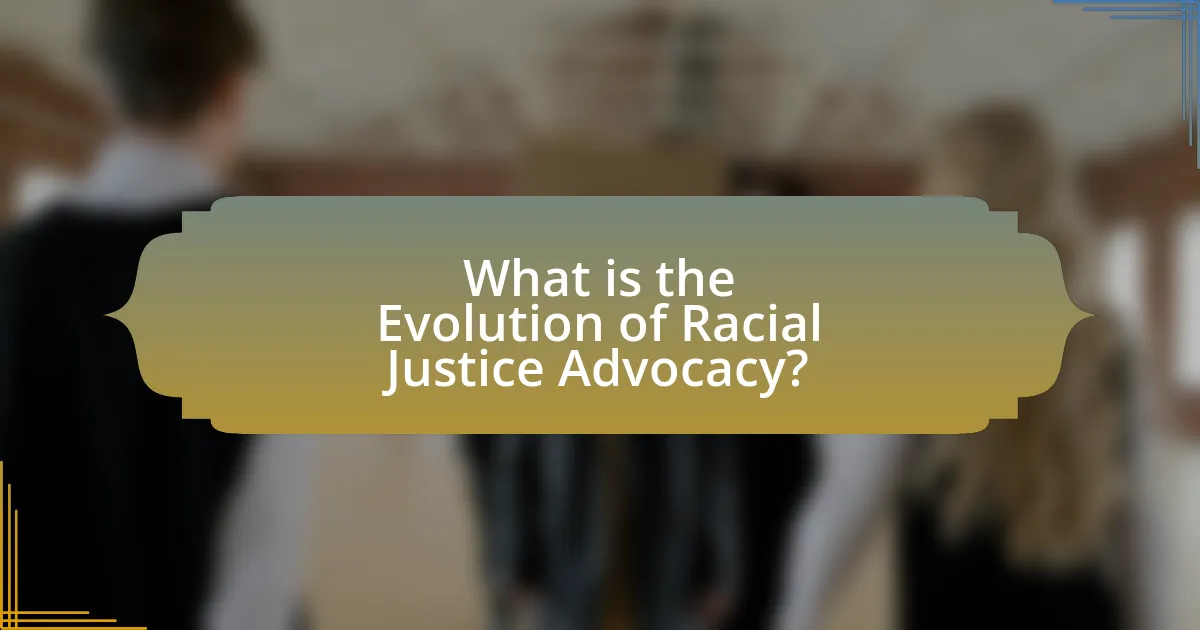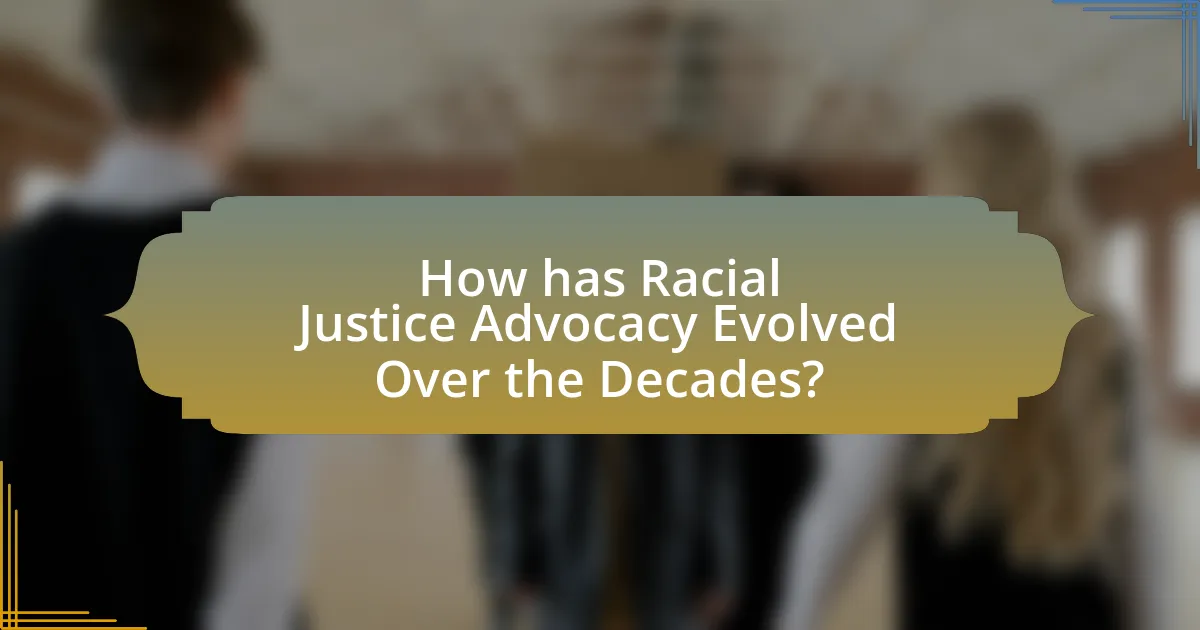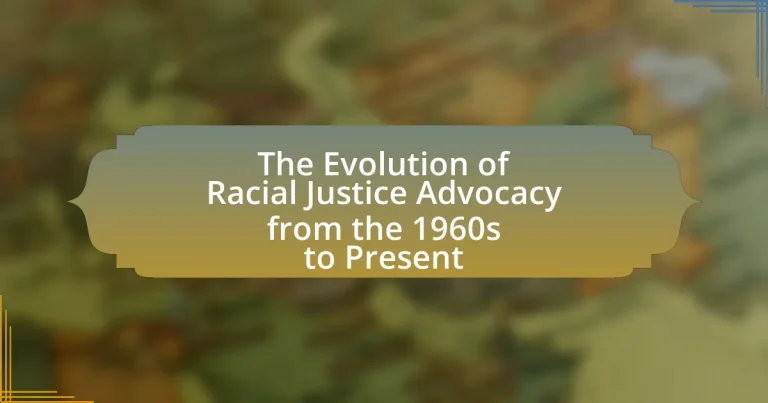The article examines the evolution of racial justice advocacy from the 1960s to the present, highlighting significant movements, key figures, and legislative milestones. It begins with the Civil Rights Movement, which aimed to end segregation and secure voting rights, leading to landmark legislation such as the Civil Rights Act of 1964 and the Voting Rights Act of 1965. The discussion progresses to contemporary movements like Black Lives Matter, which address systemic racism and police violence, utilizing social media for mobilization. The article also explores the ongoing challenges faced by advocates, including systemic racism, political polarization, and the impact of public policy on future efforts for racial equity.

What is the Evolution of Racial Justice Advocacy?
The evolution of racial justice advocacy has progressed significantly from the 1960s to the present, marked by key movements and legislative changes. In the 1960s, the Civil Rights Movement, led by figures such as Martin Luther King Jr. and organizations like the NAACP, focused on ending segregation and securing voting rights, culminating in landmark legislation like the Civil Rights Act of 1964 and the Voting Rights Act of 1965.
In the following decades, advocacy expanded to address systemic inequalities, with movements such as Black Lives Matter emerging in the 2010s in response to police violence against Black individuals. This contemporary advocacy utilizes social media to mobilize support and raise awareness, reflecting a shift towards grassroots organizing and intersectionality.
The evolution is evidenced by the increasing recognition of racial justice as a critical issue in public discourse, with numerous studies highlighting persistent disparities in areas such as education, employment, and criminal justice. For instance, the Pew Research Center reported in 2020 that 76% of Black Americans viewed racial discrimination as a significant problem, underscoring the ongoing need for advocacy.
How did racial justice advocacy begin in the 1960s?
Racial justice advocacy began in the 1960s primarily through the Civil Rights Movement, which aimed to end racial segregation and discrimination against African Americans. Key events, such as the Montgomery Bus Boycott in 1955 and the March on Washington in 1963, galvanized public support and highlighted the need for legislative change. The movement led to significant legal advancements, including the Civil Rights Act of 1964 and the Voting Rights Act of 1965, which aimed to dismantle institutional racism and ensure equal rights. These actions were driven by grassroots organizations, prominent leaders like Martin Luther King Jr., and widespread protests, establishing a foundation for ongoing racial justice efforts.
What were the key events that shaped the early movement?
The key events that shaped the early movement for racial justice include the Civil Rights Act of 1964, the Voting Rights Act of 1965, and the formation of organizations such as the NAACP and SNCC. The Civil Rights Act of 1964 prohibited discrimination based on race, color, religion, sex, or national origin, marking a significant legislative victory for the movement. The Voting Rights Act of 1965 aimed to eliminate barriers to voting for African Americans, leading to increased voter registration and participation. Additionally, the NAACP, founded in 1909, and the Student Nonviolent Coordinating Committee (SNCC), established in 1960, played crucial roles in organizing protests, voter registration drives, and advocating for civil rights, thereby laying the groundwork for future advancements in racial justice.
Who were the prominent figures in the 1960s racial justice advocacy?
Prominent figures in the 1960s racial justice advocacy included Martin Luther King Jr., Malcolm X, Rosa Parks, and John Lewis. Martin Luther King Jr. was a key leader of the Civil Rights Movement, known for his nonviolent protests and the “I Have a Dream” speech delivered during the 1963 March on Washington. Malcolm X advocated for Black empowerment and was a prominent figure in the Nation of Islam before later promoting a more inclusive approach. Rosa Parks is celebrated for her pivotal role in the Montgomery Bus Boycott, which became a catalyst for the movement. John Lewis, as a leader of the Student Nonviolent Coordinating Committee, played a significant role in organizing protests and was a key figure in the Selma to Montgomery marches. These individuals significantly shaped the landscape of racial justice advocacy during the 1960s.
What were the main goals of racial justice advocacy during the 1960s?
The main goals of racial justice advocacy during the 1960s included the elimination of racial segregation, the protection of voting rights for African Americans, and the promotion of equal economic opportunities. Advocacy groups, such as the NAACP and the Southern Christian Leadership Conference, aimed to dismantle Jim Crow laws that enforced racial discrimination in the South. The Civil Rights Act of 1964 and the Voting Rights Act of 1965 were significant legislative achievements that resulted from these efforts, addressing systemic inequalities and ensuring legal protections against discrimination.
How did these goals reflect the social and political climate of the time?
The goals of racial justice advocacy from the 1960s to the present reflect a response to systemic racism and social inequality prevalent during those times. In the 1960s, the Civil Rights Movement aimed to dismantle segregation and secure voting rights, responding to widespread discrimination and violence against African Americans, exemplified by events like the Selma to Montgomery marches in 1965. As societal awareness grew, subsequent goals evolved to address broader issues such as police brutality, economic disparity, and intersectionality, mirroring the increasing recognition of diverse voices within the movement. The Black Lives Matter movement, which gained prominence in the 2010s, specifically highlighted police violence and systemic injustice, reflecting a contemporary political climate that demands accountability and reform, as evidenced by the widespread protests following the deaths of individuals like George Floyd in 2020. These goals illustrate a continuous struggle against oppression, shaped by the changing dynamics of society and politics over decades.
What strategies were employed to achieve these goals?
Strategies employed to achieve racial justice advocacy goals include grassroots organizing, legal challenges, and coalition-building. Grassroots organizing mobilized communities to raise awareness and demand change, exemplified by movements like the Civil Rights Movement, which utilized protests and sit-ins to challenge segregation. Legal challenges, such as landmark cases like Brown v. Board of Education, aimed to dismantle institutional racism through the judicial system. Coalition-building among diverse groups, including labor unions and religious organizations, strengthened the advocacy efforts by uniting various stakeholders around common goals, as seen in the formation of the Rainbow Coalition in the 1980s. These strategies collectively contributed to significant legislative changes, such as the Civil Rights Act of 1964 and the Voting Rights Act of 1965, demonstrating their effectiveness in advancing racial justice.

How has Racial Justice Advocacy Evolved Over the Decades?
Racial justice advocacy has evolved significantly from the 1960s to the present, transitioning from a focus on civil rights legislation to a broader agenda addressing systemic racism and social justice. In the 1960s, key events such as the Civil Rights Act of 1964 and the Voting Rights Act of 1965 marked pivotal moments in the fight against racial discrimination, primarily targeting legal inequalities. Over the decades, advocacy has expanded to include issues like police brutality, economic disparities, and environmental justice, as seen in movements like Black Lives Matter, which emerged in response to high-profile cases of racial violence in the 2010s. This evolution reflects a growing recognition of the interconnectedness of various forms of oppression and the need for comprehensive approaches to achieve racial equity.
What significant changes occurred in the 1970s and 1980s?
Significant changes in racial justice advocacy during the 1970s and 1980s included the emergence of new organizations and strategies aimed at addressing systemic racism. The establishment of groups like the National Association for the Advancement of Colored People (NAACP) Legal Defense Fund and the Southern Christian Leadership Conference (SCLC) shifted focus towards legal challenges and grassroots mobilization. Additionally, the Civil Rights Act of 1964 and the Voting Rights Act of 1965 laid the groundwork for subsequent advocacy efforts, leading to increased political representation for African Americans. The 1980s also saw the rise of intersectionality in advocacy, recognizing the interconnectedness of race, gender, and class issues, which was further articulated by scholars like Kimberlé Crenshaw. These developments marked a transition from the earlier civil rights movement to a broader understanding of racial justice that included economic and social dimensions.
How did legislation impact racial justice advocacy during this period?
Legislation significantly advanced racial justice advocacy from the 1960s to the present by establishing legal frameworks that prohibited discrimination and promoted equality. Key laws, such as the Civil Rights Act of 1964 and the Voting Rights Act of 1965, provided essential protections against racial discrimination in various sectors, including employment, education, and voting. These legislative measures empowered advocacy groups by legitimizing their efforts and providing legal avenues to challenge injustices. For instance, the Civil Rights Act enabled organizations like the NAACP to pursue litigation against discriminatory practices, leading to landmark court rulings that furthered civil rights.
What role did grassroots organizations play in the evolution of the movement?
Grassroots organizations were pivotal in the evolution of the racial justice movement by mobilizing communities, raising awareness, and advocating for policy changes. These organizations, such as the Student Nonviolent Coordinating Committee (SNCC) and the Black Panther Party, played crucial roles in grassroots activism, organizing protests, and voter registration drives, which were essential in challenging systemic racism. For instance, SNCC’s efforts in the 1960s led to significant voter registration among African Americans in the South, directly impacting the political landscape and contributing to the passage of the Voting Rights Act of 1965. Additionally, grassroots organizations have continuously adapted their strategies to address contemporary issues, ensuring that the movement remains relevant and effective in advocating for racial justice today.
How did the 1990s and 2000s reshape racial justice advocacy?
The 1990s and 2000s reshaped racial justice advocacy by introducing new strategies and expanding the focus beyond traditional civil rights issues. During this period, advocacy groups began to emphasize intersectionality, recognizing how race intersects with gender, class, and sexuality, which led to a broader understanding of systemic inequality. The rise of technology and the internet facilitated grassroots organizing and mobilization, exemplified by campaigns like the Million Man March in 1995, which highlighted the importance of Black male identity and community. Additionally, high-profile incidents of racial violence, such as the police beating of Rodney King in 1991 and the subsequent Los Angeles riots, galvanized public awareness and activism, prompting a renewed focus on police brutality and criminal justice reform. These developments collectively transformed racial justice advocacy into a more inclusive and multifaceted movement, addressing a wider array of social justice issues.
What new challenges emerged for racial justice advocates during these decades?
Racial justice advocates faced new challenges during these decades, including the rise of systemic racism in institutions, the emergence of digital misinformation, and the fragmentation of movements. Systemic racism became more entrenched in policies and practices, making it difficult for advocates to achieve meaningful reform. The proliferation of social media introduced challenges related to misinformation and the rapid spread of divisive narratives, complicating efforts to unify public support. Additionally, the fragmentation of movements, with various groups prioritizing different issues, led to a lack of cohesive strategy and focus, hindering collective action. These challenges required advocates to adapt their strategies and approaches to effectively address the evolving landscape of racial justice.
How did technology influence advocacy efforts in this era?
Technology significantly enhanced advocacy efforts in the era of racial justice by facilitating communication, mobilization, and awareness. The rise of social media platforms, such as Twitter and Facebook, allowed activists to disseminate information rapidly, organize protests, and engage a global audience. For instance, the hashtag #BlackLivesMatter emerged in 2013, uniting individuals and groups around the cause and amplifying their voices in response to police violence. Additionally, mobile technology enabled real-time documentation of events, leading to increased accountability and visibility of injustices. According to a study by the Pew Research Center, 69% of Americans reported that social media played a crucial role in their understanding of racial issues, demonstrating the profound impact of technology on public perception and advocacy strategies.

What is the Current State of Racial Justice Advocacy?
The current state of racial justice advocacy is characterized by a heightened awareness and mobilization around systemic racism, particularly following events such as the murder of George Floyd in 2020. Advocacy groups have gained significant traction, with organizations like Black Lives Matter leading protests and influencing public discourse on racial inequality. According to a 2021 Pew Research Center survey, 61% of Americans believe that the movement for racial justice has made progress, yet 55% also feel that more work is needed to achieve true equality. This duality reflects ongoing challenges, including disparities in policing, education, and healthcare, which continue to fuel advocacy efforts.
How has the Black Lives Matter movement influenced contemporary advocacy?
The Black Lives Matter movement has significantly influenced contemporary advocacy by reshaping the discourse around racial justice and police reform. This movement has mobilized millions globally, emphasizing the importance of intersectionality and grassroots organizing, which has led to increased visibility for issues such as systemic racism and social inequality. For instance, the movement’s use of social media has allowed for rapid dissemination of information and mobilization, exemplified by the viral spread of hashtags like #BlackLivesMatter, which has galvanized protests and policy discussions. Additionally, the movement has prompted organizations and institutions to adopt more inclusive practices and policies, as seen in the increased funding for racial equity initiatives and the implementation of diversity training programs across various sectors.
What strategies are currently being used to promote racial justice?
Current strategies to promote racial justice include grassroots organizing, policy advocacy, and educational initiatives. Grassroots organizing involves mobilizing communities to raise awareness and demand systemic change, exemplified by movements like Black Lives Matter, which gained momentum after high-profile incidents of racial violence. Policy advocacy focuses on legislative reforms aimed at dismantling systemic racism, such as the George Floyd Justice in Policing Act, which seeks to address police misconduct and accountability. Educational initiatives aim to foster understanding and dialogue about racial issues, often through workshops and training programs that emphasize anti-racism and inclusivity. These strategies collectively work to challenge and change the structures that perpetuate racial inequality.
How do current movements address intersectionality in racial justice?
Current movements address intersectionality in racial justice by explicitly recognizing and advocating for the interconnectedness of various social identities, including race, gender, sexuality, and class. For instance, organizations like Black Lives Matter incorporate intersectional frameworks to highlight how systemic racism disproportionately affects marginalized groups, such as Black women and LGBTQ+ individuals. This approach is supported by academic research, such as Kimberlé Crenshaw’s work on intersectionality, which illustrates that individuals experience multiple forms of discrimination simultaneously. By centering these diverse experiences, current movements aim to create more inclusive policies and practices that address the unique challenges faced by different communities within the broader struggle for racial justice.
What challenges does racial justice advocacy face today?
Racial justice advocacy today faces significant challenges, including systemic racism, political polarization, and misinformation. Systemic racism persists in various institutions, affecting access to education, healthcare, and employment opportunities for marginalized communities. Political polarization has led to a divided public discourse, making it difficult to build consensus on racial justice issues. Additionally, misinformation spreads rapidly through social media, undermining efforts to educate the public and mobilize support for racial justice initiatives. These challenges hinder progress and complicate the advocacy landscape, as evidenced by ongoing disparities in wealth and health outcomes among different racial groups.
How do systemic issues continue to impact racial justice efforts?
Systemic issues, such as institutional racism, economic inequality, and biased legal frameworks, continue to significantly hinder racial justice efforts. These systemic barriers perpetuate disparities in education, employment, and criminal justice, making it difficult for marginalized communities to achieve equity. For instance, a 2020 report by the Economic Policy Institute found that Black workers earn 73% of what their white counterparts earn, illustrating the economic inequality rooted in systemic issues. Additionally, the Sentencing Project reported that Black Americans are incarcerated at more than five times the rate of white Americans, highlighting the impact of biased legal systems on racial justice. These entrenched systemic issues create a cycle of disadvantage that complicates and often undermines efforts aimed at achieving racial justice.
What role does public policy play in shaping the future of racial justice advocacy?
Public policy plays a crucial role in shaping the future of racial justice advocacy by establishing legal frameworks and funding mechanisms that support equity initiatives. Effective public policies can address systemic inequalities by implementing anti-discrimination laws, promoting equal access to education and employment, and ensuring fair policing practices. For instance, the Civil Rights Act of 1964 and the Voting Rights Act of 1965 were pivotal in dismantling institutional racism, demonstrating how legislative action can lead to significant societal change. Furthermore, contemporary policies that focus on criminal justice reform, such as the First Step Act of 2018, illustrate ongoing efforts to rectify past injustices and promote racial equity. These examples underscore the importance of public policy as a tool for advancing racial justice and shaping advocacy efforts in the future.
What practical steps can individuals take to support racial justice advocacy?
Individuals can support racial justice advocacy by actively participating in community organizing and educational initiatives. Engaging in local advocacy groups allows individuals to amplify marginalized voices and contribute to policy changes. For instance, volunteering with organizations focused on racial equity, such as the NAACP or local grassroots movements, provides direct support to ongoing efforts. Additionally, individuals can educate themselves and others about systemic racism through workshops, reading materials, and discussions, which fosters a more informed community. Research indicates that informed communities are more likely to engage in advocacy, as seen in the increased participation in protests and policy advocacy following educational campaigns.


